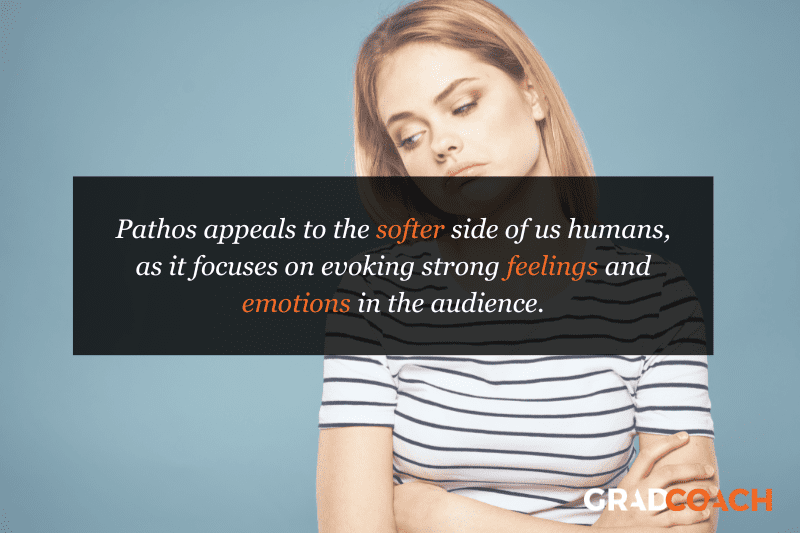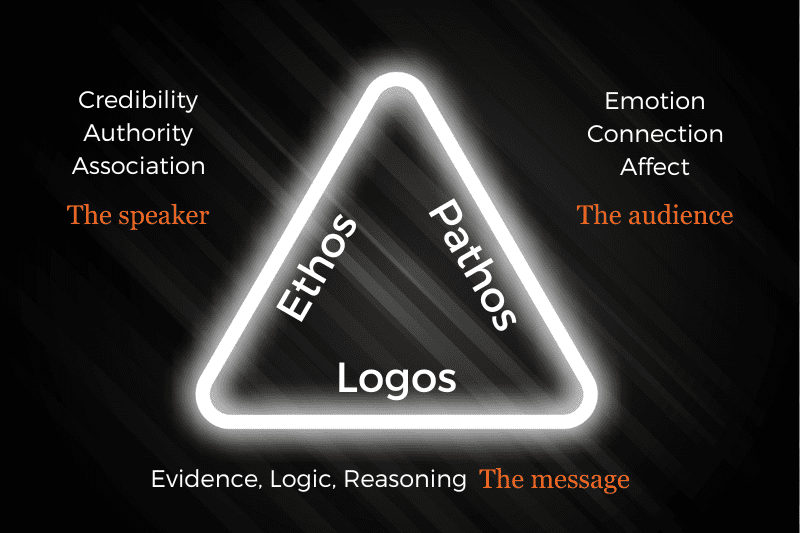If you spend any amount of time exploring the wonderful world of philosophy, you’re bound to run into the dynamic trio of rhetorical appeals: logos, ethos and pathos. But, what exactly do they mean and how can you use them in your writing or speaking? In this post, we’ll unpack the rhetorical love triangle in simple terms, using loads of practical examples along the way.
Overview: The Rhetorical Triangle
- What are logos, pathos and ethos?
- Logos unpacked (+ examples)
- Pathos unpacked (+ examples)
- Ethos unpacked (+ examples)
- The rhetorical triangle
What are logos, ethos and pathos?
Simply put, logos, ethos and pathos are three powerful tools that you can use to persuade an audience of your argument. At the most basic level, logos appeals to logic and reason, while pathos appeals to emotions and ethos emphasises credibility or authority.
Naturally, a combination of all three rhetorical appeals packs the biggest punch, but it’s important to consider a few different factors to determine the best mix for any given context. Let’s look at each rhetorical appeal in a little more detail to understand how best to use them to your advantage.

Logos 101
Logos appeals to the logical, reason-driven side of our minds. Using logos in an argument typically means presenting a strong body of evidence andfacts to support your position. This evidence should then be accompanied by sound logic and well-articulated reasoning.
Let’s look at some examples of logos in action:
- A friend trying to persuade you to eat healthier might present scientific studies that show the benefits of a balanced diet and explain how certain nutrients contribute to overall health and longevity.
- A scientist giving a presentation on climate change might use data from reputable studies, along with well-presented graphs and statistical analyses to demonstrate the rising global temperatures and their impact on the environment.
- An advertisem*nt for a new smartphone might highlight its technological features, such as a faster processor, longer battery life, and a high-resolution camera. This could also be accompanied by technical specifications and comparisons with competitors’ models.
In short, logos is all about using evidence, logic and reason to build a strong argument that will win over an audience on the basis of its objective merit. This contrasts quite sharply against pathos, which we’ll look at next.

Pathos 101
Contrasted to logos, pathos appeals to the softer side of us mushy humans. Specifically, it focuses on evoking feelings and emotions in the audience. When utilising pathos in an argument, the aim is to cultivate some feeling of connection in the audience toward either yourself or the point that you’re trying to make.
In practical terms, pathos often uses storytelling, vivid language and personal anecdotes to tap into the audience’s emotions. Unlike logos, the focus here is not on facts and figures, but rather on psychological affect. Simply put, pathos utilises our shared humanness to foster agreement.
Let’s look at some examples of pathos in action:
- An advertisem*nt for a charity might incorporate images of starving children and highlight their desperate living conditions to evoke sympathy, compassion and, ultimately, donations.
- A politician on the campaign trail might appeal to feelings of hope, unity, and patriotism to rally supporters and motivate them to vote for his or her party.
- A fundraising event may include a heartfelt personal story shared by a cancer survivor, with the aim of evoking empathy and encouraging donations to support cancer research.
As you can see, pathos is all about appealing to the human side of us – playing on our emotions to create buy-in and agreement.

Ethos 101
Last but not least, we’ve got ethos. Ethos is all about emphasising the credibility and authority of the person making the argument, or leveraging off of someone else’s credibility to support your own argument.
The ethos card can be played by highlighting expertise, achievements, qualifications and accreditations, or even personal and professional associations and connections. Ultimately, the aim here is to foster some level of trust within the audience by demonstrating your competence, as this will make them more likely to take your word as fact.
Let’s look at some examples of ethos in action:
- A fitness equipment brand might hire a well-known athlete to endorse their product.
- A toothpaste brand might make claims highlighting that a large percentage of dentists recommend their product.
- A financial advisor might present their qualifications, certifications and professional memberships when meeting with a prospective client.
As you can see, using ethos in an argument is largely about emphasising the credibility of the person rather than the logical soundness of the argument itself (which would reflect a logos-based approach). This is particularly helpful when there isn’t a large body of evidence to support the argument.
Ethos can also overlap somewhat with pathos in that positive emotions and feelings toward a specific person can oftentimes be extended to someone else’s argument. For example, a brand that has nothing to do with sports could still benefit from the endorsem*nt of a well-loved athlete, just because people feel positive feelings about the athlete – not because of that athlete’s expertise in the product they’re endorsing.

How to use logos, pathos and ethos
Logos, pathos and ethos combine to form the rhetorical triangle, also known as the Aristotelian triangle. As you’d expect, the three sides (or corners) of the triangle reflect the three appeals, but there’s also another layer of meaning. Specifically, the three sides symbolise the relationship between the speaker, the audience and the message.

Without getting too philosophical, the key takeaway here is that logos, pathos and ethos are all tools that you can use to present a persuasive argument. However, how much you use each tool needs to be informed by careful consideration of who your audience is and what message you’re trying to convey to them.
For example, if you’re writing a research paper for a largely scientific audience, you’ll likely lean more heavily on the logos. Conversely, if you’re presenting a speech in which you argue for greater social justice, you may lean more heavily on the pathos to win over the hearts and minds of your audience.
Simply put, by understanding the relationship between yourself (as the person making the argument), your audience, and your message, you can strategically employ the three rhetorical appeals to persuade, engage, and connect with your audience more effectively in any context. Use these tools wisely and you’ll quickly notice what a difference they can make to your ability to communicate and more importantly, to persuade.